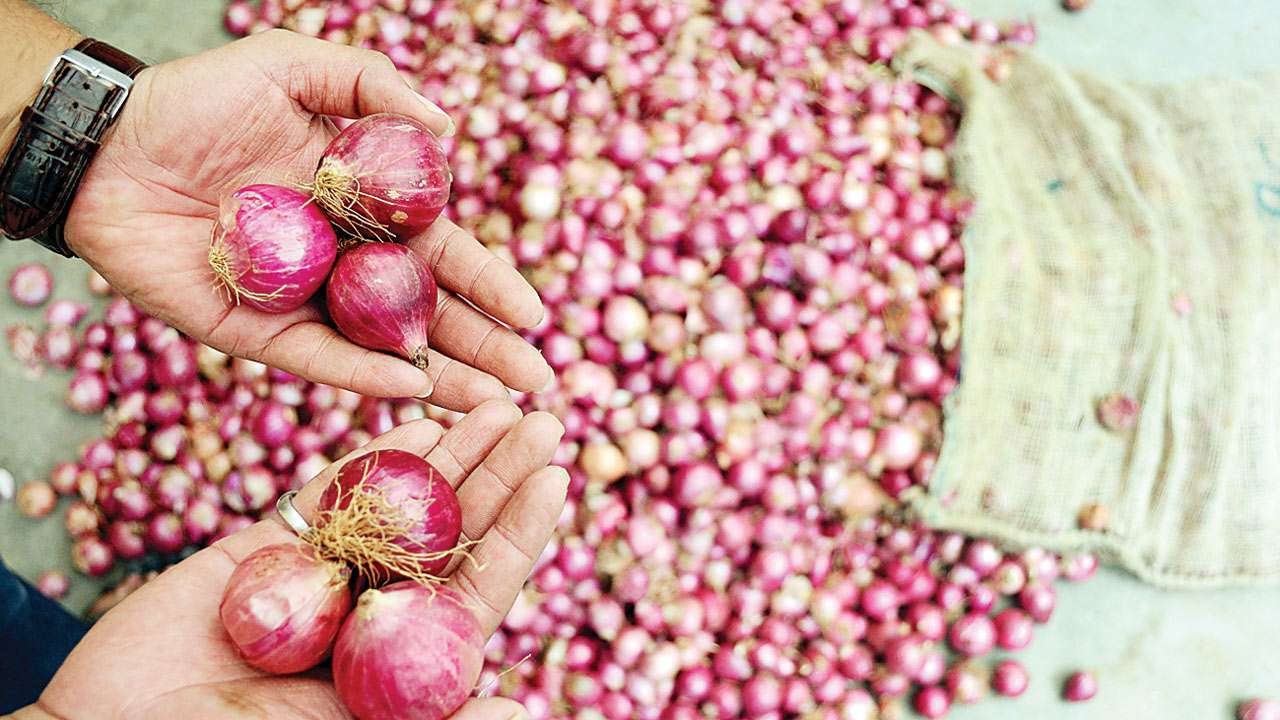From Tomatoes To Onions, Surging Prices Shake Grocery Bills, What’s Next?
After the price hike in tomatoes, onions have joined the list causing chaos in the grocery budget for Indian households.

From Tomatoes To Onions, Surging Prices Shake Grocery Bills, What’s Next?
Surge in Onion Prices
In a pungent turn of events, onion prices in key markets across the nation have experienced a dramatic substantial surge, leaving consumers in tears as the cost of this essential kitchen staple has doubled in some places. Maharashtra’s Pimpalgaon as well as Lasalgoan Agriculture Market Committee, which is known as Asia’s largest onion market, has experienced an alarming escalation in onion prices, setting off alarms for households nationwide.
Onion prices increased dramatically from INR 1,200 per quintal to INR 1,900 from August 5 to 7 before staggeringly rising to INR 2,500 per quintal on August 9. The shockwaves of this spike in prices are already being felt in the retail sphere, where prices hover around INR 30 per kilo. Unfortunately, the bitter onion tale may just be just getting started. According to analysts, prices will likely increase significantly soon and will likely approach INR 60–70 per kilo by early September.
There is a multifarious offender that is responsible for this onion chaos. The foundation of this price upheaval has been speculative buying, driven by the declining area under onion production during this monsoon and the depletion of carry-forward rabi supplies. According to data from the agriculture ministry, the area of onions that had been sown in the kharif crop as of July 31 had decreased by an unsettling 13 percent from the same time last year. The dismally low amount of rainfall in Maharashtra, a major onion-producing region, adds to this already low year-over-year total.
)
According to independent farm sector researcher Deepak Chavan, this year’s sowing has been hindered by the shortage of rainfall in the majority of Maharashtra. Onion seed sales have also decreased by approximately thirty percent this year. These elements have combined to produce an environment that is conducive to price speculation and hoarding, shaking the market.
The effects of this price increase extend beyond simple annoyance and penetrate further into the socio-economic structure. In important onion-producing regions like Maharashtra, Madhya Pradesh, and Rajasthan, the high temperatures in February hastened the rabi crop’s maturation. The quality as well as shelf life of onions were significantly compromised by unseasonal rainfall in March. Panic selling occurred in February and March when the shelf life decreased from six months to just a period of four to five months causing the demand-supply mismatch to worsen.
While investors and hoarders may take pleasure in their profits, the average consumer suffers the most. The murky side of the matter was clarified by an unidentified official from the Maharashtra APMC mandi, who said, “Traders in the industry have started hoarding, storing them in large quantities as they expect a shortage to soon take over the market.” Such hoarding behaviors fuel the fire and increase the financial pressure on households.
A ray of optimism appears in the form of a possible cooling off in onion prices, even though it will not happen until October. According to industry analysts, some respite may arrive when the next supply of onions enters the market. However, the infamous CRISIL study serves as a timely reminder that a “major slump seems unlikely.” The expected annual production of onions is 29 million metric tonnes, which is only modestly 7 percent more than the average over the previous five years. This upward trend’s tenacity is clear, and it paints a picture of persistent price problems.
CRISIL Research Predictions
In the most recent study reveal, Crisil warned consumers that prices for onions are expected to rise sharply in the near future. According to the estimate, retail onion prices could soar to a stunning INR 60–70 per kilogram commencing in early September. This unsettling forecast is due to an anticipated shortage in onion supplies, which has been made worse by odd weather that has interfered with normal supply timetables.
According to Crisil’s study, the early maturity of the rabi crop, unseasonal rainfall, and decreased shelf life because of storage issues are the main causes of this looming onion catastrophe. Due to high temperatures in important agricultural areas like Maharashtra, Madhya Pradesh, and Rajasthan, the rabi crop, which is usually introduced to the market in March, was made available one month earlier in February. This early influx of supply, along with the later Kharif arrivals, resulted in an unexpected glut in the market.

Moreover, unseasonal rainfall in March further worsened the quality of onions, decreasing their shelf life from the usual six months to a mere period of 4-5 months. This unfortunate turn of events led to panic selling through farmers, heightening the supply-demand imbalance as well as further accelerating the approaching price hike.
Consumers Brace for Price Hike, Relief Anticipated in October
According to the research by Crisil, the sad truth is that customers should brace themselves for higher onion prices as early as September, with prices possibly rising to INR 60-70 per kilogram during the lean season. The research does, however, offer a glimmer of hope: after Kharif arrivals begin in October, onion supply should steadily improve and prices should decline.
This is emphasized by Pushan Sharma, Director at Crisil, who notes that despite the possibility of an improvement in October, the price increase may have a long-lasting impact on farmers’ attitudes. The production of Kharif onions this year may decline by 5% as a result of this pessimism, which may result in a reduction in acreage.
Crisil tries to soothe investors despite the bleak forecast by saying that while prices are anticipated to increase, they would still be below the highs projected in 2020. For customers who are already struggling with high food prices, this is a silver lining. In addition, the data from Crisil points out that despite the farmers’ dissatisfaction, the estimated yearly production of 29 million metric tonnes actually amounts to 7 percent greater than the average over the previous five years.
After Tomatoes, Price of Onions on the rise
Since the phenomena of growing tomato prices has persisted for more than a month, the market has been volatile for a considerable amount of time. In the case of tomatoes, the impact of production seasonality and sporadic shocks on price swings is particularly pronounced.
Unseasonal rains and extended droughts play a crucial role in causing unanticipated price shocks, according to the Economic Survey of 2021–2022, which examines the volatility of prices for staple vegetables like tomatoes and onions. The current situation, where supply disruptions brought on by rain are escalating the price increase, makes this link between weather patterns and price instability clear.
The Economic Survey also emphasizes how susceptible tomatoes and onions are to supply chain breakdowns, which are currently occurring as a result of transportation issues brought on by landslides and excessive rain in Himachal Pradesh. Vegetable transportation takes longer as a result, which immediately affects prices because logistical costs are higher. Wholesalers at Azadpur Mandi, like Sanjai Bhagat, have emphasized the difficulties of exporting vegetables under such circumstances, potentially resulting in price increases.
While the price of tomatoes has received a lot of attention, it is important to note that the price of onions fluctuates similarly in Indian markets. The relationship between the price changes of these two common vegetables highlights the broader market factors at work.
Prices are generally unstable due to seasonal output variations and unanticipated shocks, both climatic and otherwise. A complicated interplay of market forces, seasonality, and outside causes has caused the jump in tomato costs, which will be followed by the anticipated increase in onion prices. The current circumstance, made worse by unfavorable weather, emphasizes how susceptible perishable goods are to supply chain interruptions.

Way Forward- Need for Regulatory Mechanisms
As the critical situation unfolds, it becomes apparent that the lessons drawn from this episode of price hike should not be ignored, in order to prevent history from repeating itself in future. While the prospects of market stabilization by October offer a glimmer of hope, the scars left behind by this ordeal serve as a sobering reminder of the instability and precarious nature of essential commodity pricing dynamics.
As households brace for the potential pinch in their wallets due to escalating grocery bills, the requirement for comprehensive action from policymakers as well as industry stakeholders cannot be overstated. The root causes which lay the groundwork for these distressing fluctuations must be addressed head-on to make sure the resilience of India’s food supply and the steadiness of its economy.
In every market, supply and demand have historically been the primary factors influencing price changes, and the onion and tomato market is no different. This delicate balance can be disturbed by unpredictable weather patterns, crop diseases, and logistical difficulties. However, the disproportionate impact of speculative trading just makes things worse. In order to make rapid money, traders frequently manipulate prices by taking advantage of the market’s weakness. This alters the true dynamics of both demand and supply as well as producing fake price spikes.
The predicament indicates the critical need for regulatory tools that prevent speculation and advance price transparency. A system that is open and accountable can reduce unfair price increases by protecting customers from needless financial constraints. Additionally, by making improvements to the infrastructure for distribution, shipping, and storage, supply-side issues that frequently accentuate price volatility may be reduced.
Although it may be tempting to see this scenario only as an economic problem, there are more serious consequences. The affordability of everyday items like onions and tomatoes, which are staples in Indian kitchens, has a direct impact on millions of people’s lives. Price increases in certain commodities may have a domino effect on other economic sectors, contribute to inflation, and cascade into other markets.
The ongoing onion and tomato price crisis ought to act as a wake-up call for consumers, industry actors, and governments alike. The fragility of the food supply chain calls for a proactive strategy that addresses both long-term structural problems as well as short-term market stability. India can do this by developing a more resilient agriculture sector that guarantees the accessibility and affordability of necessary goods even in the face of challenges.
In conclusion, the price fluctuations of tomatoes and onions serve as a stark example of the complex dance between supply, demand, as well as speculative activity in the marketplace. The long-lasting effects of this episode highlight the brittleness of fundamental commodity pricing dynamics, notwithstanding the possibility of market stability looming in the distance. The goal now is to use this incident as a springboard for reform, ushering in a more transparent, robust, as well as sustainable system which safeguards both consumer and national economic interests.




